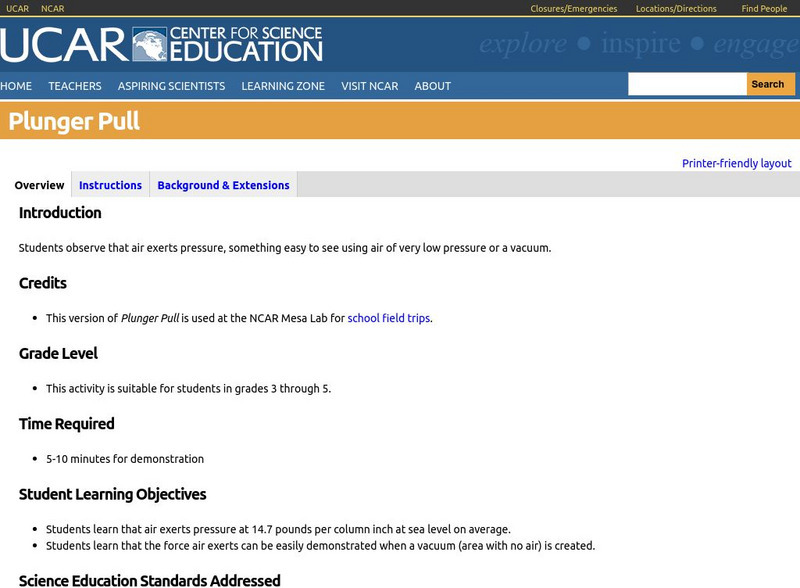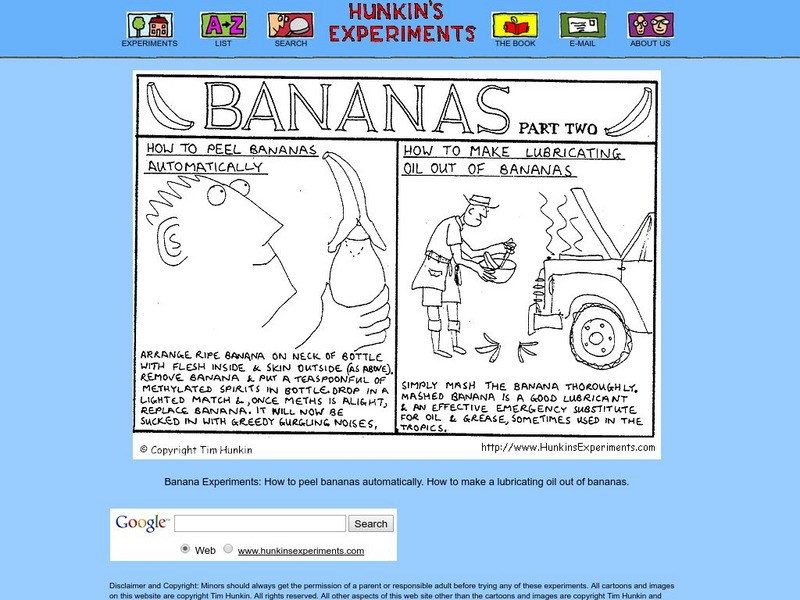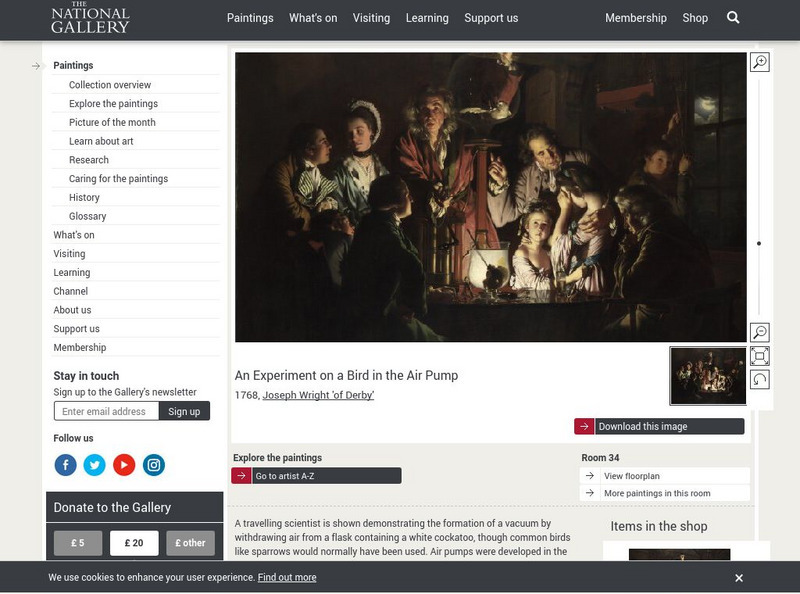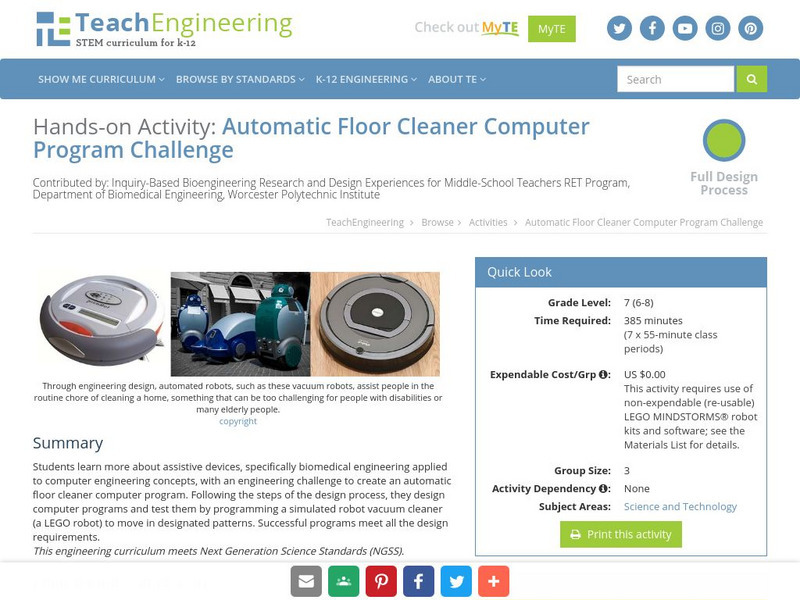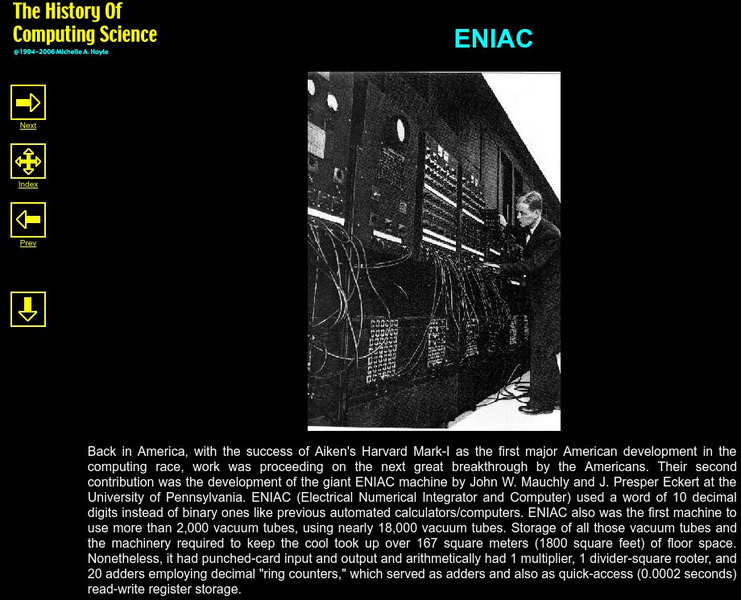University Corporation for Atmospheric Research
Ucar: Plunger Pull
Students observe that air exerts pressure, something easy to see using air of very low pressure or a vacuum.
National Inventors Hall of Fame
National Inventors Hall of Fame: William D. Coolidge: Vacuum Tube (X Ray)
This site provides a brief biography on William D. Coolidge, inventor of the X-ray tube, also known as the "Coolidge tube."
Hunkins Experiments
Hunkin's Experiments: Potato Peel a Banana Automatically
Hunkin's Experiments is a group of simple cartoon illustrations of scientific principles. Some would work well in the classroom, but others have little value beyond entertaining students. All of the projects are easy to do. This one is a...
The National Gallery (UK)
The National Gallery: Experiment on a Bird in the Air Pump
As part of a larger exhibit on science and the history of scientific instruments, this site examines a painting by Joseph Wright and its connection to the scientific studies of the vacuum. The painting, which is accompanied by a...
National High Magnetic Field Laboratory
Magnet Academy: Audion 1906
Two years after Englishman John Ambrose Fleming invented a two-electrode vacuum tube, American inventor Lee De Forest one-upped him by developing a tube with three electrodes.
Science Buddies
Science Buddies: How Does Color Affect Heating by Absorption of Light?
Light is an example of an electromagnetic wave. Electromagnetic waves can travel through the vacuum of interstellar space. They do not depend on an external medium-unlike a mechanical wave such as a sound wave which must travel through...
BBC
Bbc: Earth: Tardigrades Return From the Dead
Tardigrades are ancient, fascinating creatures that can survive conditions that would kill most life forms, including extreme heat and absolute zero, extreme pressure and a vacuum, and deadly radiation. They can even survive being...
TeachEngineering
Teach Engineering: Automatic Floor Cleaner Computer Program Challenge
Students learn more about assistive devices, specifically biomedical engineering applied to computer engineering concepts, with an engineering challenge to create an automatic floor cleaner computer program. Following the steps of the...
History of Computing Science
History of Computing Science: Eniac
The ENIAC (Electrical Numerical Integrator and Computer)was a large computer based on vacuum tubes and introduced in 1946. This lecture gives a brief presentation of the ENIAC.
PBS
Pbs: Transistorized!
This site provides a tour of the discovery and development of the transistor form PBS, including video and lesson plans.
Other
Lee De Forest, American Inventor: The Complete Lee De Forest
An extensive site covering all aspects of Lee de Forest, his inventions, writings, and personal life. Find drawings and pictures of his audion tube and find out about his legacy, especially in the world of electronics.
Science Struck
Science Struck: What Is Gravity and How Does It Work
A very detailed look at gravitational force and the many theories that have been put forward to try to explain it. Includes lots of illustrations.
PBS
Pbs Learning Media: How Big Is the Universe?
In this media-rich essay from the NOVA Web site, astronomer Brent Tully of the University of Hawaii walks you through the latest scientific theories about the size of the universe.
TED Talks
Ted: Ted Ed: How Heavy Is Air?
Too often we think of air as empty space- but compared to a vacuum, air is actually pretty heavy. Dan Quinn describes the fundamentals of air pressure and explains how it affects our bodies, the weather, and the universe at large. [3:19]
Symmetry Magazine
Symmetry Magazine: Explain It in 60 Seconds: Cherenkov Light
Cherenkov light is explained here as the light emitted when a charged particle travels through matter faster than light would be able to. This would be slower, however, than the maximum speed of light, which occurs in a vacuum. "Explain...
PBS
Pbs Teachers: Mysteries of the Universe
Consider the issues surrounding the world of space exploration including the new fields of archaeoastronomy and astrobiology. Investigate zero gravity, the Big Bang theory, life in space and how sound travels in a vacuum.
National High Magnetic Field Laboratory
Magnet Academy: Walter Brattain (1902 1987)
Walter Houser Brattain discovered the photo-effect that occurs at the free surface of a semiconductor and was co-creator of the point-contact transistor, which paved the way for the more advanced types of transistors that eventually...
Exploratorium
Exploratorium: Science Snacks: Falling Feather
Recreate Galileo famous demonstration to show that a heavy and light weighted object fall at the same acceleration in a vacuum.
National Pest Managment Association
Pest World for Kids: Sort the Bugs
A fast-paced game where you must eliminate the insects by sorting three types of bugs into jars, hitting flies with a fly swatter, picking ticks up with tweezers, or vacuuming up stink bugs.
Other
Sri: Erma and Micr, the Origin of Electronic Banking
Discusses the history of electronic banking, banking problems, vacuum tubes vs. transistors, magnetic ink character reading, handling paper at high speed, and the ERMA.
Council for Economic Education
Econ Ed Link: Tapped Dry: How Do You Solve a Water Shortage?
Economists do not operate in a vacuum. If an economist is going to suggest that the price of a good needs to be increased, he or she needs to consider who will bear the increase in costs. Will the costs be distributed equally or will one...
Carnegie Endowment for International Peace
Carnegie Endowment for International Peace: Lebanon, Path of Democracy [Pdf]
After the withdrawal of Syrian troops, Lebanon is faced with rebuilding its political structure. Unfortunately the nature of political parties in Lebanon could lead to a power vacuum. This Carnegie paper was written in 2006.
BBC
Bbc: Gcse Bitesize: Why Do Scientists Think That Light and Sound Are Waves?
Light travels as transverse waves and can travel through a vacuum. Sound travels as longitudinal waves and needs to travel through a solid, liquid or gas. Read about the properties of light and of sound, and learn the differences between...
Alabama Learning Exchange
Alex: Automotive Brakes Power Assist Units
This lesson will orient the student to the operation of vacuum operated and hydraulically assisted power booster units. The student will be able to effectively diagnose and repair problems with these systems at the conclusion of the lesson.
Other popular searches
- Crankcase Vacuum
- Vacuum Tube
- Vacuum Cyclones
- Vacuum Flask
- Vacuum Chamber Demo
- Vacuum Forming Processes
- Gas Pressure Vacuums
- Vacuum Pump
- Vacuum Forming
- Vacuum Chamber


